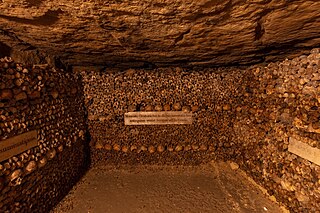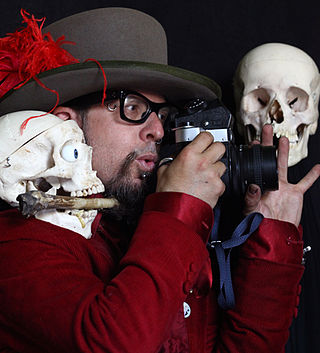
The Catacombs of Paris are underground ossuaries in Paris, France, which hold the remains of more than six million people. Built to consolidate Paris's ancient stone quarries, they extend south from the Barrière d'Enfer former city gate; the ossuary was created as part of the effort to eliminate the effects of the city's overflowing cemeteries. Preparation work began shortly after a 1774 series of basement wall collapses around the Holy Innocents' Cemetery added a sense of urgency to the cemetery-eliminating measure, and from 1786, nightly processions of covered wagons transferred remains from most of Paris's cemeteries to a mine shaft opened near the Rue de la Tombe-Issoire.

Catacombs are human-made underground passages primarily used for religious purposes, particularly for burial. Any chamber used as a burial place is considered a catacomb, although the word is most commonly associated with the Roman Empire.

The Order of Friars Minor Capuchin is a religious order of Franciscan friars within the Catholic Church, one of three "First Orders" that reformed from the Franciscan Friars Minor Observant, the other being the Conventuals (OFMConv). Franciscans reformed as Capuchins in 1525 with the purpose of regaining the original Habit (tunic) of St. Francis of Assisi and also for returning to a stricter observance of the rule established by Francis of Assisi in 1209.

The Sedlec Ossuary is a Roman Catholic chapel, located beneath the Cemetery Church of All Saints, part of the former Sedlec Abbey in Sedlec, a suburb of Kutná Hora in the Czech Republic. The ossuary is estimated to contain the skeletons of between 40,000 and 70,000 people, whose bones have, in many cases, been artistically arranged to form decorations and furnishings for the chapel. The ossuary is among the most visited tourist attractions of the Czech Republic, drawing over 200,000 visitors annually.

An ossuary is a chest, box, building, well, or site made to serve as the final resting place of human skeletal remains. They are frequently used where burial space is scarce. A body is first buried in a temporary grave, then after some years the skeletal remains are removed and placed in an ossuary. The greatly reduced space taken up by an ossuary means that it is possible to store the remains of many more people in a single tomb than possible in coffins. The practice is sometimes known as grave recycling.

The Catacombs of Rome are ancient catacombs, underground burial places in and around Rome, of which there are at least forty, some rediscovered only in recent decades.
A skull and crossbones is a symbol consisting of a human skull and two long bones crossed together under or behind the skull. The design originated in the Late Middle Ages as a symbol of death and especially as a memento mori on tombstones.

Santa Maria della Concezione dei Cappuccini is a Roman Catholic church located at Via Vittorio Veneto, 27, just north of the Piazza Barberini, in Rome, Italy. It is the first Roman church dedicated to the Immaculate Conception.

Saint Peter's tomb is a site under St. Peter's Basilica that includes several graves and a structure said by Vatican authorities to have been built to memorialize the location of Saint Peter's grave. St. Peter's tomb is alleged near the west end of a complex of mausoleums, the Vatican Necropolis, that date between about AD 130 and AD 300. The complex was partially torn down and filled with earth to provide a foundation for the building of the first St. Peter's Basilica during the reign of Constantine I in about AD 330. Though many bones have been found at the site of the 2nd-century shrine, as the result of two campaigns of archaeological excavation, Pope Pius XII stated in December 1950 that none could be confirmed to be Saint Peter's with absolute certainty. Following the discovery of bones that had been transferred from a second tomb under the monument, on June 26, 1968, Pope Paul VI said that the relics of Saint Peter had been identified in a manner considered convincing. Only circumstantial evidence was provided to support the claim.

The Capuchin Catacombs of Palermo are burial catacombs in Palermo, Sicily, southern Italy. Today they provide a somewhat macabre tourist attraction as well as an extraordinary historical record.

A charnel house is a vault or building where human skeletal remains are stored. They are often built near churches for depositing bones that are unearthed while digging graves. The term can also be used more generally as a description of a place filled with death and destruction.

The Capela dos Ossos is one of the best-known monuments in Évora, Portugal. It is a small interior chapel located next to the entrance of the Church of St. Francis. The Chapel gets its name because the interior walls are covered and decorated with human skulls and bones.

The Capuchin Church in Vienna, Austria, is a Catholic church and monastery run by the Order of Friars Minor Capuchin. Located on the Neuer Markt square in the Innere Stadt near the Hofburg Palace, the Capuchin Church is most famous for containing the Imperial Crypt, the final resting place for members of the House of Habsburg. The official name is the Church of Saint Mary of the Angels.

Santa Maria dell'Orazione e Morte is a church in central Rome, Italy. It lies on Via Giulia between the Tiber and the Palazzo Farnese.

The Skull Chapel is an ossuary chapel located in the Czermna district of Kudowa-Zdrój, in southwestern Poland. Built in Baroque style in the last quarter of the 18th century, the temple serves as a mass grave with thousands of skulls and human skeletal remains adorning its interior walls, floor, ceiling, and foundations. The Skull Chapel is the only such monument in Poland, and one of five in Europe.

Skull symbolism is the attachment of symbolic meaning to the human skull. The most common symbolic use of the skull is as a representation of death.

Paul Koudounaris is an American author and photographer originally from Los Angeles and currently living in Las Vegas. He has a PhD in Art History, and his publications in the field of charnel house and ossuary research have made him a well-known figure in the field of macabre art and art history. He is also a feline historian whose book entitled, A Cat's Tale, told feline history in the voice of his rescue cat, Baba the Cat. In addition he is one of the world's leading experts on pet cemeteries and animal burials, and his book on this topic was announced in 2024 for a fall release under the title Faithful Unto Death, He is a member of The Order of the Good Death.

The Nibbia Chapel was a Roman Catholic chapel in Valletta, Malta, which was dedicated to Our Lady of Mercy. It was originally built in 1619 by Fra Giorgio Nibbia, a knight of the Order of St. John, and it was located near a cemetery where deceased patients from the nearby Sacra Infermeria were buried.

The Catacombs of Saint Gaudiosus are underground paleo-Christian burial sites, located in the northern area of the city of Naples.

St Leonard's Church is a Church of England parish church in Hythe, Kent. It was originally built in the late 11th century and is a Grade I listed building.




















